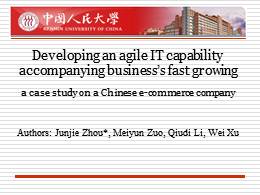Copy and paste the code below into your blog post or website
Copy URL
Embed into WordPress (learn more)
Comments
comments powered by DisqusPresentation Slides & Transcript
Presentation Slides & Transcript
Developing an agile IT capability accompanying business’s fast growing
a case study on a Chinese e-commerce company
Authors: Junjie Zhou*, Meiyun Zuo, Qiudi Li, Wei Xu
Motivation
Businesses confronting turbulent environment
i.e., globalization, dramatic regulatory uncertainties, acute time-to-market pressures, and technology advancement
Information technology (IT) arising everywhere
acting as the engine driving competition (McAfee & Brynjolfsson 2008)
a sharp increase in the quantity and quality of IT investments
IT capability becoming a hot topic
IT capability
Definition
is considered as the organisational comprehensive ability, not only including hard capabilities of IT infrastructure, but also soft capabilities of utilizing IT resources, i.e., IT infrastructure capability, IT business spanning capability and IT proactive stance (Lu & Ramamurthy 2011)
Importance of IT capability
enabler of developing enterprise agility (Sambamurthy et al. 2003; Overby et al. 2006; Van Oosterhout et al. 2006)
significant effect on organizational business, performance, strategy and competitive advantage (Melville et al. 2004)
Gaps
Gap 1: always treated as a causal factor already existing Few studies have analyzed how IT capability is developed (Bi et al. 2011)
Gap 2: Not paying much attention to those fast growing enterprises (Jordan & Pham 2011)
3-year compound annual sales growth rate of 80% or above(Zook & Allen 1999 ); only one in seven firms generate sustained, profitable growth (Barringer et al. 2005)
RQ: how those fast growing enterprises develop their IT capability accompanying business’s fast growing
Methodology
Case study
is well suited for theory construction and testing, helpful to answer the questions on “how” and “why”through deeply analysis (Eisenhardt 1989; Eisenhardt & Graebner 2007)
Case selection
An interesting case and also extremely situation?Pan & Tan 2011; Pettigrew 1990?
was set up in 1998 and a pure physical store before entering e-commerce; had been keeping growing by the rate more than 200% since entering e-commerce area in 2004
its sale exceeding 10 billion RMB and accounting for 35.6% market share in China’s B2C market in the year 2010; becoming one of Top 3 B2C e-commerce enterprises in China in 2010
Case description
Data cellection & analysis
Data cellection
Secondary archive; Internal publications; Interview
Data analysis
Process model: focusing specifically on sequences of events over time in order to explain how and why particular outcomes are reached (Newman & Robey 1992)
Three-step process: Identifying Problems?Designing Mechanisms ?Concrete Actions
Three-period: Pre-event (planning the whole)? During-the-event (strengthening collaboration)? Post-event (keeping feedback)
Data analysis
Analyzing the three-step process in each period
Pre-event: planning the whole
During-the-event: strengthening collaboration
Post-event: keeping feedback
Conclusions
How
Through planning the whole in the pre-event period, strengthening collaboration in the during-the-event period, and keeping feedback in the post-event, obtaining three capabilities, respectively scientific planning capability, improvisation capability and timely feedback capability
Agile IT capability
BI systems and elaborate data analysis? a sustainable and expansible IS systems; person interaction between business department and IT department ? a fusion of IT knowledge and business knowledge; scientific planning ? a proactive stance
Agile: scientific planning, improvisation, and timely feedback
Contributions
Theoretical implications
explore how IT capability is developed, which is a popular yet often understudied concept, which would be a source of general guidance in stimulating future research
Conceptualize the phenomenon, which is helpful to the future studies
construct a process model to explain how IT capability is developed, which will rich the studies of IT capability and dynamic capability theory
Practical implications
dissect a fast growing company, which offers an vivid example of how to develop IT capability
summarize a process model, will sheds lights to IT managers who are in the similar situation
Limitations and future work
Limitations
A single case: the problem of external validity
an EC enterprise
all interviewees from IT department
Future work
observing this company to analyze how IT capability is evolving
analyzing its IT strategy along with the company’s growing
Thanks!
Q&A
Theoretical foundation
Dynamic capability theory
dynamic capability: the firm’s ability to integrate, build, and reconfigure internal and external competences to address rapidly changing environments (Teece et al. 1997)
used to link corporate resources and rapidly changing environment together, and answer the questions that how organizational resources are developed, utilized and integrated into firms (Winter 2003)
Theoretical foundation (continued)
Critical literature review
dimensions of IT capability (Bhatt et al. 2005; Lu & Ramamurthy 2011; Peppard and Ward 2004)
e-commerce: combine all kinds of resources in new ways and do this repeatedly and rapidly (Daniel & Wilson 2003)
identify four distinct types of agile IT adoption practices, through the appropriate use of organizational control mechanisms contingent upon trust of its stakeholders (Goh et al. 2010)
to provide the right information to the right customers at the right time, giving rise to a firm-specific IT capability (Bi et al. 2011)






